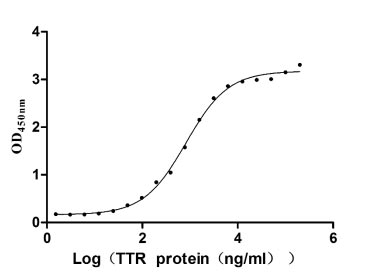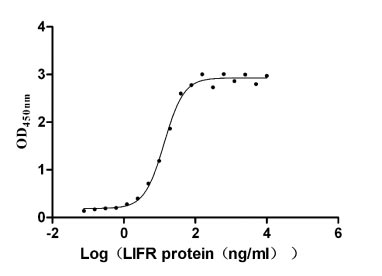Recombinant Human Nociceptin receptor (OPRL1), partial
-
货号:CSB-YP016360HU1
-
规格:
-
来源:Yeast
-
其他:
-
货号:CSB-EP016360HU1
-
规格:
-
来源:E.coli
-
其他:
-
货号:CSB-EP016360HU1-B
-
规格:
-
来源:E.coli
-
共轭:Avi-tag Biotinylated
E. coli biotin ligase (BirA) is highly specific in covalently attaching biotin to the 15 amino acid AviTag peptide. This recombinant protein was biotinylated in vivo by AviTag-BirA technology, which method is BriA catalyzes amide linkage between the biotin and the specific lysine of the AviTag.
-
其他:
-
货号:CSB-BP016360HU1
-
规格:
-
来源:Baculovirus
-
其他:
-
货号:CSB-MP016360HU1
-
规格:
-
来源:Mammalian cell
-
其他:
产品详情
-
纯度:>85% (SDS-PAGE)
-
基因名:
-
Uniprot No.:
-
别名:OPRL1; OOR; ORL1; Nociceptin receptor; Kappa-type 3 opioid receptor; KOR-3; Orphanin FQ receptor
-
种属:Homo sapiens (Human)
-
蛋白长度:Partial
-
蛋白标签:Tag type will be determined during the manufacturing process.
The tag type will be determined during production process. If you have specified tag type, please tell us and we will develop the specified tag preferentially. -
产品提供形式:Lyophilized powder
Note: We will preferentially ship the format that we have in stock, however, if you have any special requirement for the format, please remark your requirement when placing the order, we will prepare according to your demand. -
复溶:We recommend that this vial be briefly centrifuged prior to opening to bring the contents to the bottom. Please reconstitute protein in deionized sterile water to a concentration of 0.1-1.0 mg/mL.We recommend to add 5-50% of glycerol (final concentration) and aliquot for long-term storage at -20℃/-80℃. Our default final concentration of glycerol is 50%. Customers could use it as reference.
-
储存条件:Store at -20°C/-80°C upon receipt, aliquoting is necessary for mutiple use. Avoid repeated freeze-thaw cycles.
-
保质期:The shelf life is related to many factors, storage state, buffer ingredients, storage temperature and the stability of the protein itself.
Generally, the shelf life of liquid form is 6 months at -20°C/-80°C. The shelf life of lyophilized form is 12 months at -20°C/-80°C. -
货期:Delivery time may differ from different purchasing way or location, please kindly consult your local distributors for specific delivery time.Note: All of our proteins are default shipped with normal blue ice packs, if you request to ship with dry ice, please communicate with us in advance and extra fees will be charged.
-
注意事项:Repeated freezing and thawing is not recommended. Store working aliquots at 4°C for up to one week.
-
Datasheet :Please contact us to get it.
相关产品
靶点详情
-
功能:G-protein coupled opioid receptor that functions as receptor for the endogenous neuropeptide nociceptin. Ligand binding causes a conformation change that triggers signaling via guanine nucleotide-binding proteins (G proteins) and modulates the activity of down-stream effectors. Signaling via G proteins mediates inhibition of adenylate cyclase activity and calcium channel activity. Arrestins modulate signaling via G proteins and mediate the activation of alternative signaling pathways that lead to the activation of MAP kinases. Plays a role in mo...显示更多
-
基因功能参考文献:
- The rs2229205 SNP in the OPRL1 gene may be a genetic factor that contributes to individual differences in the vulnerability to smoking in Japanese individuals PMID: 27490265
- The results of in vitro Ala scanning analyses revealed that the labeled residues were Cys59 in TM1, Cys215 and Cys231 in TM5, and Cys310 in TM7. The present study has provided a novel method of Cys(Npys)-affinity labeling for identification of the ligand-binding sites in the ORL1 receptor. PMID: 27271345
- Study presents evidence suggesting that the PNOC and OPRL1 are dysregulated in suicide completers, thereby potentially contributing to impaired emotional and behavioral control and, ultimately, to the suicidal crisis PMID: 26349406
- Data suggest that nociceptin and nociceptin receptor evolved as one of 4 opioid receptor systems in vertebrates; this system exhibits both analgesic and hyperalgesic effects. [REVIEW] PMID: 25677768
- Opioid neuropeptide systems are important mediators of ovarian steroid signaling that regulate reproduction in female; data suggest that nociceptin and nociceptin receptor system in arcuate nucleus of hypothalamus is such a system. [REVIEW] PMID: 25677773
- Data suggest that the nociceptin/nociceptin receptor system is involved in modulation of the immune response and in pathogenesis of autoimmune diseases. [REVIEW] PMID: 25677775
- Data suggest that the nociceptin/nociceptin receptor system is involved in modulation of psychological and inflammatory stress responses and in pathogenesis of anxiety. [REVIEW] PMID: 25677776
- Data suggest that interaction between the nociceptin/nociceptin receptor system and the orexin/orexin receptor system in neurons of the hypothalamus positively and negatively modulate complex and integrated responses to stress. [REVIEW] PMID: 25677777
- Data suggest that nociceptin/nociceptin receptor signaling in neurons of the hippocampus modulate learning and memory. [REVIEW] PMID: 25677778
- Overall methylation levels in the promoter regions of three genes (ALDH1A1, OPRL1 and RGS19) are elevated in subjects who were exposed to childhood adversity. PMID: 23799031
- Oprl1 is associated with amygdala function, fear processing, and posttraumatic stress disorder symptoms. PMID: 23740899
- Dominant-positive Arrestin3 but not Arrestin2 was sufficient to rescue NOPR-S363A internalization and JNK signaling. PMID: 23086955
- Decreased plasma nociceptin/orphanin FQ is closely associated with the presence of acute cardiovascular disease, and the severity of symptoms has a significant negative correlation with the N/OFQ levels. PMID: 22849833
- crystal structure of human NOP (also known as ORL-1), solved in complex with the peptide mimetic antagonist compound-24 PMID: 22596163
- Our studies reported here show that ORL1 exhibits the ability to cross-desensitize CXCR4 in both primary leukocytes and hematopoetic cell lines PMID: 21656184
- The presence of at least one C allele is associated with a decreased expression of OLR1 mRNA in the absence of hsa-miR369-3p de-regulation PMID: 21709374
- OPRL1 expression was 1.83 times higher in vitiligo involved skin when compared to healthy control skin. PMID: 20888736
- study provides evidence for an association of two variants of the OPRL1 gene, rs6090041 and rs6090043, with vulnerability to develop opiate addiction, suggesting a role for nociceptin/orphanin FQ receptor in the development of opiate addiction PMID: 20032820
- Our results support the concept postulating that chronic ethanol consumption and withdrawal downregulate the PNOC/OPRL1 system, which critically controls alcohol intake. PMID: 19501074
- Data show that the dynamic cycle between nociceptin receptor activation, internalization and recycling determines the activity of this receptor on the cell surface. PMID: 12568343
- Nociceptin receptor mRNA is expressed in human trigeminal ganglia but not in basilar arteries. PMID: 12576178
- OP4/ORL1 receptor is synthesized and functionally expressed in vascular endothelial cells, presumably as a starting point for some vasoactive mechanism(s). PMID: 14660000
- Nociceptin-induced receptor endocytosis mainly occurred via clathrin-coated pits. Mainly internalized through the endosome compartment. Receptor phosphorylation necessary for internalization. PMID: 15016723
- Results suggest that opioid receptor-like (ORL1) receptor utilizes both G(oA) and G(oB) for signal transduction. PMID: 16800795
- The ORL-1 receptor is expressed by all subtypes of leukocytes; its function is not the modulation of cytokine production and requires further studies. PMID: 16807742
- Polymorphism not associated with panic disorder. PMID: 17167337
- molecular analysis of the nociceptin receptor and its ligand complexes PMID: 17456499
- We analyzed 10 single nucleotide polymorphisms (SNPs) in OPRL1 and 15 SNPs in PNOC in a sample of 1923 European Americans from 219 multiplex alcohol dependent families PMID: 17910740
- However, there was evidence in support of LD between the OLR1+1071, the OLR1+1073, and the rs669 SNPs, with T-C-A haplotype being associated with significant increased risk of AD. PMID: 18191876
- Human CD14(+) monocytes expresses the mRNA for ORL1. The ORL1/nociceptin system plays a role in regulating chemotactic responses of leukocytes through chemokine suppression. PMID: 18247127
- We genotyped 15 single nucleotide polymorphisms (SNPs) spanning the OPRL1 locus and found that SNP rs6010718 was significantly associated with both Type I and Type II alcoholics. PMID: 18269382
- existence of a cross-talk between NOP and kainate receptors, leading to an interplay between glutamate and N/OFQ circuits PMID: 18286384
收起更多
-
亚细胞定位:Cell membrane; Multi-pass membrane protein. Cytoplasmic vesicle. Note=Ligand binding leads to receptor internalization into cytoplasmic vesicles, decreasing the amount of available receptor at the cell surface. Internalization requires phosphorylation at Ser-363. Can recycle to the cell membrane.
-
蛋白家族:G-protein coupled receptor 1 family
-
组织特异性:Detected in blood leukocytes.
-
数据库链接:
HGNC: 8155
OMIM: 602548
KEGG: hsa:4987
STRING: 9606.ENSP00000336764
UniGene: Hs.2859



-AC1.jpg)
















